Hibiscus plants enjoy growing in marshy soil. But it makes the plant an easy target for overwatering. The potted plants are more prone to overwatering than the grounded ones.
Excessive watering and poor drainage are common reasons for an overwatered Hibiscus plant. To save an overwatered hibiscus plant, remove the plant from the soil, trim the damaged parts of the roots and repot the plant. Water the plant when the top 1-2 inches of the soil is dry to prevent it.
If your grounded plant got overwatered, remove the damaged parts and shift the plant to a dry location.
This guide will provide you with deep knowledge about the signs of overwatering, ways to fix it, and the correct watering guide.
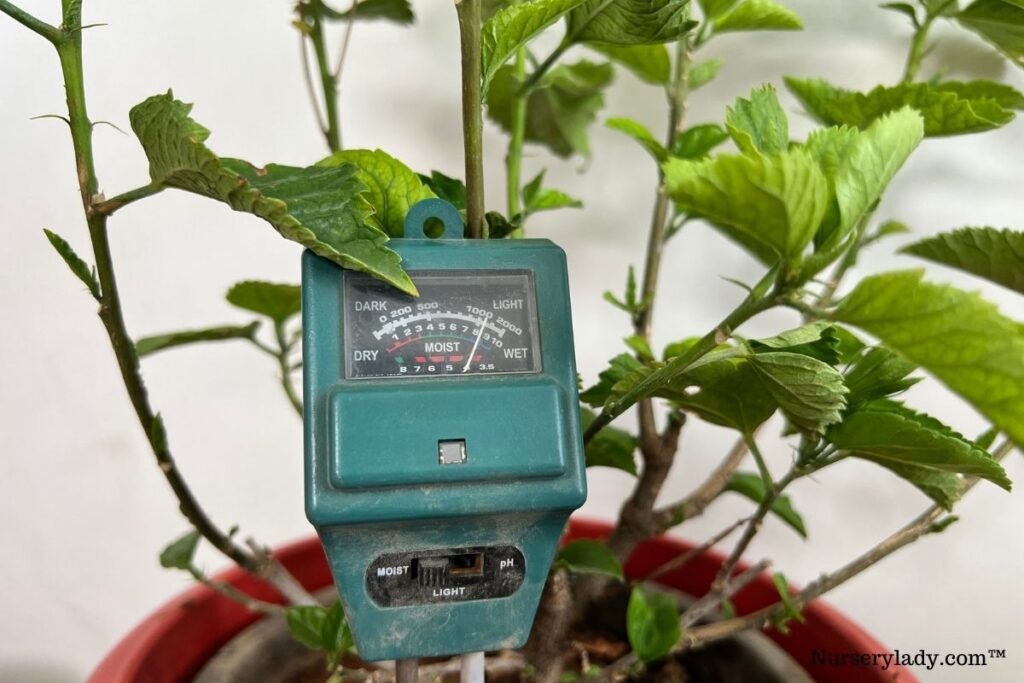
Overwatering a Hibiscus plant
Many gardeners commit overwatering by mistake, including both experienced and novice ones.
Understanding the right watering frequency and the amount is of utmost importance if you want your plant to remain healthy for long.
Hibiscus plants are sun-loving plants.
Since they stay under the sunlight for 6 to 8 hours, they will require enough water to survive.
But, be careful during the rainy season and winters.
If the plant is outside, reduce watering during frequent rain.
The rain will fulfill its water demand.
In the winters, the Hibiscus grows slow or becomes dormant.
Here also you should reduce watering.
There are many other reasons behind an overwatered Hibiscus plant.
Let’s learn them.
What are the reasons behind an overwatered Hibiscus?
Watering depends on a lot of factors.
If you ignore those factors and continue casual watering, your Hibiscus will experience overwatering.
Below are some common reasons behind the overwatered Hibiscus plant.
Watering without letting the soil dry
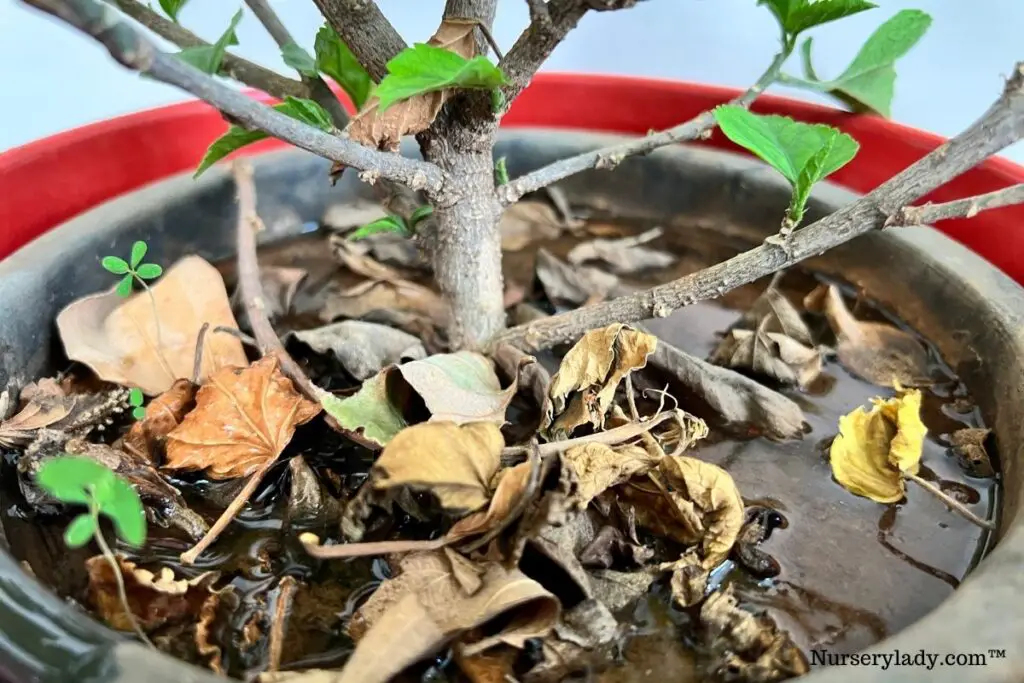
Hibiscus requires a lot of water because dry soil can force the plant to shut off its growth and blooming process.
But that doesn’t mean you should not let the soil dry out.
As a rule of thumb, allow at least the top 1-2 inches of the soil to dry out before you water them next.
It applies both to the grounded and potted plants.
If you don’t let the soil dry out, the roots will be surrounded by water and suffocate. Over time, the plant will have root rot.
Also read: How To Water Hibiscus Plant? (How Much, How Often & More)
Poor drainage
The soil should have a good balance between drainage and retention.
If it only focuses on retaining the moisture, the roots will suffocate with water.
The plant may even have signs of underwatering and poor nutrition.
It is because the roots won’t be able to pass on the water and nutrients to other parts of the plant due to suffocation.
A container without drainage holes is another reason.
Without any drainage holes, the water will remain stagnant in the soil.
The soil and the roots will again remain wet and suffocated for a long time and cause overwatering.
You are not emptying the saucer in time.
If you grew Hibiscus in containers and kept it over a saucer, check the saucer and empty it from time to time.
If the pot stands over a pool of water, the soil will soak the water from the saucer and remain wet for a long time.
Over that, if you continue normal watering, it will cause severe overwatering.
Looking for gardening supplies? We have tested 100's of products before recommending them to you guys. Check out our best pick below:
| Image | Gardening Supplies | Best Price? |
|---|---|---|
 Top
Top Top
Top | Raised Garden Bed Kit | Check On Amazon |
 | XLUX Soil Moisture Meter, Plant Water Monitor, Soil Hygrometer Sensor for Gardening, Farming, Indoor and Outdoor Plants, No Batteries Required | No Results |
 Top
Top Top
Top | 82 Pcs Garden Tools Set and Extra Succulent Tools Set | Check On Amazon |
 | Joeys Garden Expandable Garden Hose with 8 Function Hose Nozzle, Lightweight Anti-Kink Flexible Garden Hoses, Extra Strength Fabric with Double Latex Core, (50 FT, Black) | No Results |
 Top
Top Top
Top | Dual Chamber Compost Tumbler | Check On Amazon |
 Top
Top Top
Top | Sunnyglade Plant Stakes | Check On Amazon |
 Top
Top Top
Top | Organic Cold Pressed Neem Seed Oil | Check On Amazon |
 Top
Top Top
Top | Mighty Mint Gallon :-Insect and Pest Control Peppermint Oil | Check On Amazon |
 Top
Top Top
Top | Scotts DiseaseEx Lawn Fungicide | Check On Amazon |
 Top
Top Top
Top | Jacks Classic 20-20-20 All Purpose Fertilizer | Check On Amazon |
 Top
Top Top
Top | 30,000 Seeds Pollinator Attracting Wildflower Mixture | Check On Amazon |
 Top
Top Top
Top | Survival Vegetable Seeds Garden Kit-Over 16,000 Seeds | Check On Amazon |
Watering during the off-season
Hibiscus needs a lot of water to remain strong and healthy during the growing months.
Hibiscus gets overwatered more during winters.
The plant slows down its water absorption.
Your plant will go dormant in winters if the zone is cold.
And, it will slow down its growth if the zone is warm.
At this moment, the plant will not require water like the spring or summer.
Since they will become slow or dormant, they won’t utilize the water as they used to in the growing months.
Watering too much will cause overwatering.
However, you cannot stop watering. Instead, reduce the frequency.
Also read: Hibiscus Temperature Tolerance: Ideal Range+USDA Zones
How does an overwatered Hibiscus plant look?
When a plant gets overwatered, the appearance is quite frustrating because the leaves droop and change color.
To understand whether the plant is experiencing overwatering or not, the plant will display some symptoms:
Yellow or brown leaves
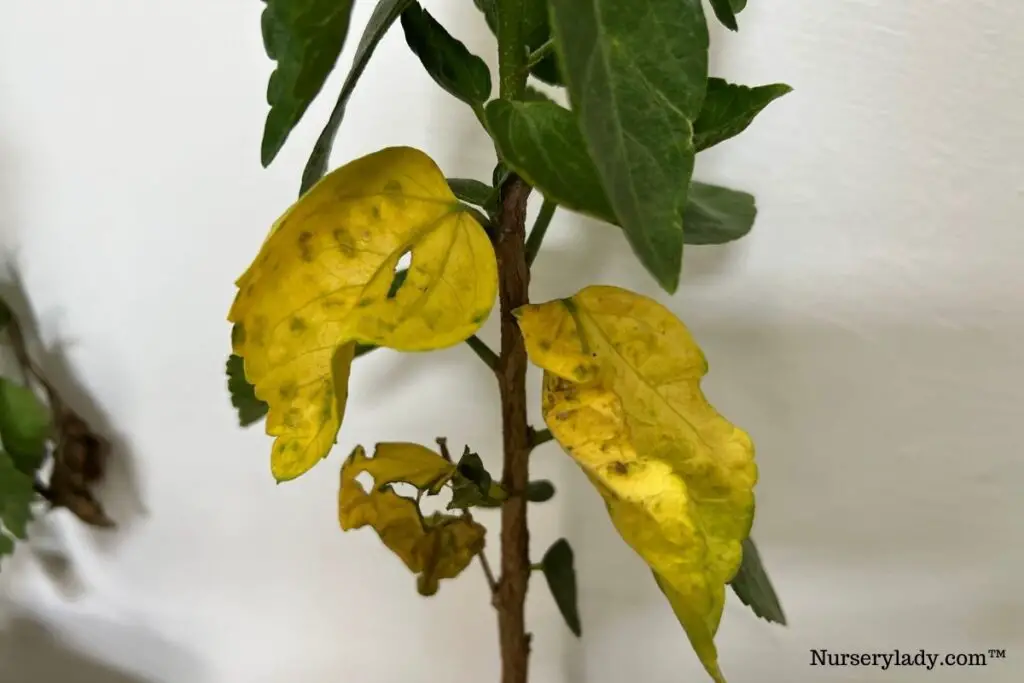
A common and evident sign is yellow or brown leaves.
However, this is also a sign of underwatering.
But in the latter, the leaves are dry and brittle.
In overwatering, the leaves will be damp.
When the roots suffocate so much water, it fails to pass on the water and nutrients to other plant parts.
As a result, the leaves turn yellow or brown.
The leaves of an overwatered Hibiscus plant are thick and spongy with yellow color.
Also read: Why Are My Hibiscus Leaves Turning Yellow? (Causes+Fix)
Wilted leaves
Since the roots remain suffocated, the water doesn’t reach every plant part.
The plant will suffer dehydration and lose the energy to stand straight.
Since this can also happen during underwatering, confirm the problem first.
Also read: Why Are Hibiscus Leaves Sticky? (Causes+How To Fix)
Soil not drying
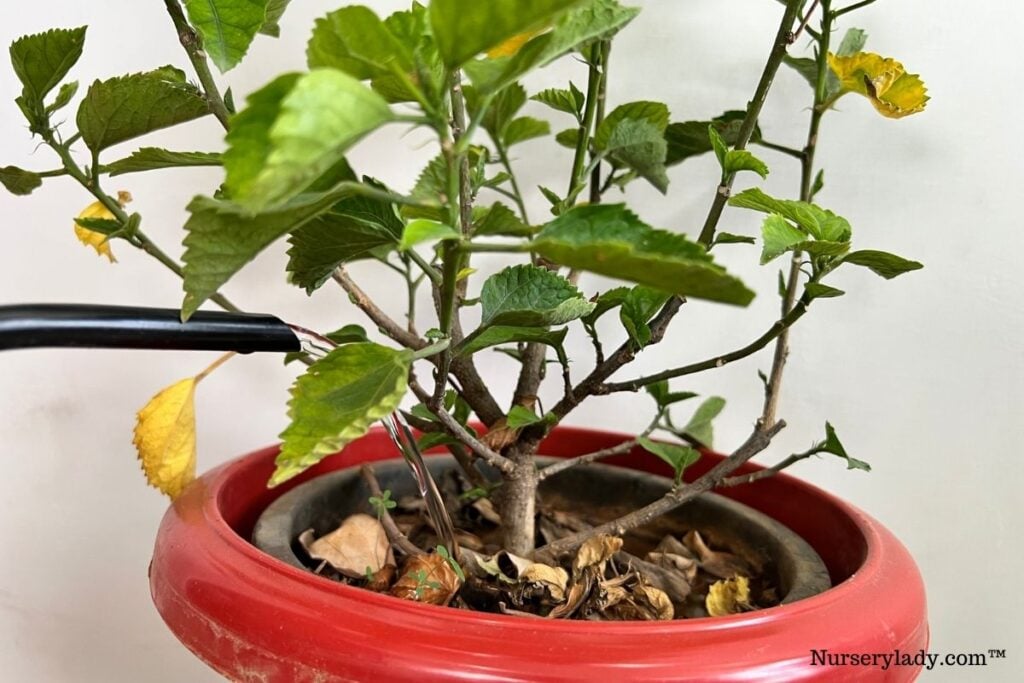
Since yellow leaves can be confusing, check the soil to confirm the problem.
An overwatered Hibiscus plant will have yellow and brown leaves and wet soil.
Root rot
To confirm the problem more, check the root system.
If you find that the roots are dark brown, soft, and mushy, then it is confirmed that the plant has been suffering from overwatering for a long time.
In worse conditions, the roots will release a foul smell, indicating Root rot disease.
What is the difference between overwatering and underwatering?
As mentioned earlier, some signs of overwatering are the same as underwatering.
But, if you don’t identify the real problem and give the plant the opposite treatment, you will kill your plant.
Don’t worry, as we have differentiated the signs of an overwatered and underwatered Hibiscus plant so that you don’t make any mistakes.
| Signs of underwatering | Signs of overwatering |
|---|---|
| Discolored leaves | Yellow or brown leaves |
| Dry and crispy leaves turning upwards | Soggy soil |
| Dry and hard soil | Thick and spongy leaves |
| Brittle leaves | Soil releasing a foul smell |
| Oedema, brown bumps caused due to accumulation of water. |
How to save an overwatered Hibiscus plant?
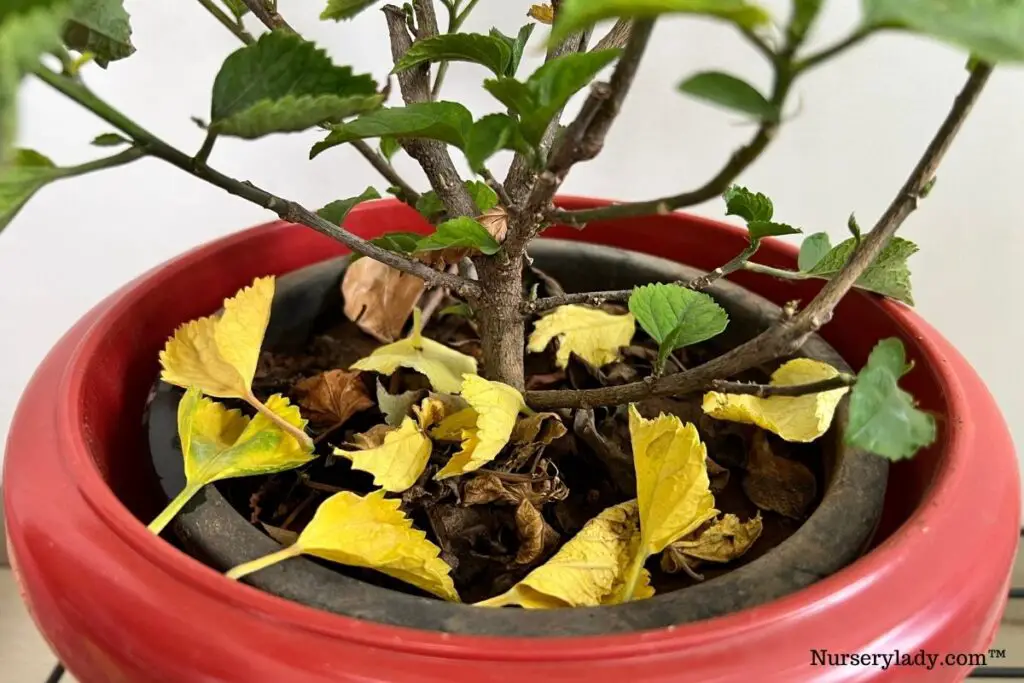
If your Hibiscus plant is overwatered, it is essential to fix the problem as soon as possible.
If the problem is caught at the initial stage, there are high chances of revival.
You can specify the problem at the first stage by observing the plant and identifying its signs daily.
For container plants:
- Check the saucer and drainage holes: Empty the saucer soon if your potted plant is standing over the saucer. Have a look at the drainage holes to check whether there are any blockages.
- Stop watering: Check the soil more often. If it is not drying out even after 2-3 days, stop watering the plant. Shift it to a brighter location to aid in quick moisture loss.
- You can also aerate the soil a bit to increase air circulation. It can give the inside soil some air to dry faster.
- Take the plant out: Once you verify that your plant is overwatered, it is time to save it. First, tap the edges of the container to loosen the soil. Then turn it over to take the plant out. You don’t have to put in any extra effort using spades or forks because the plant will come out at ease due to wet soil.
- Have a look at the roots: Once you expose the roots, remove the dirt from the roots using a brush. Check the roots to determine the extent of the damage. Please don’t wash the roots as they are already wet. If the roots have been dealing with overwatering for a short period, the roots will be firm, white, and healthy. But, if the roots are brown and mushy, the plant has been experiencing overwatering for a long time and is rotting.
- Remove the damaged parts of the plant: Once you notice the damaged roots, you have to trim them off. Letting them stay will spread the root rot fungus and damage all the roots. You can also get rid of the yellow leaves. It will improve the plant’s appearance.
- Repot the plant: If your plant is potted, take a fresh container and use clean soil. The old ones will get contaminated with the root rot fungus. However, if the roots have not started rotting yet and are still white and firm, you can use the old soil. Let the soil dry out. Don’t water the plant until the soil dries.
For repotting a root rot plant:
- Take a new container and fill it with the ideal soil mix. Make sure that the soil can drain and retain well.
- Fill half of the container with the soil.
- Make a hole at the center and place the plant in it.
- Cover the roots and surround the plant base with the remaining soil mix.
- Water the plant with little water to moisten it.
- For the first few days, be very careful while watering. Water in less amounts and check the soil.
- But make sure not to dry out the complete soil. That will give rise to other issues.
- Once the plant recovers, start normal watering. Don’t water until the top 1-2 inches of the soil is dry.
- Over time, the plant will look healthy and even develop flowers.
For grounded plants outdoors:
- Check the soil and switch off irrigation if the ground is wet.
- Aerate the soil to improve air circulation. It will help in quick moisture loss.
- Let the plant have some bright partial sunlight.
- Dig the soil around the plant base and expose the roots to check the extent of the damage level.
- If the roots are white, don’t worry much. The plant has suffered from overwatering for a very short time and will recover fast if they receive adequate light.
- Start normal watering when the top 1-3 inches of the soil has dried.
- But, if the roots are dark brown, dig the plant out to remove the damaged roots.
- Plant the Hibiscus in another dry location. Make sure it receives bright partial or dappled sunlight for several hours.
- Since the plant is stressed, don’t expose them to direct sunlight. Wait until the plant heals.
- To improve drainage, add some draining ingredients like sand, perlite, or gypsum to the soil before planting.
- Make sure that the plant doesn’t receive any stress. Don’t fertilize now. Wait until the plant has recovered.
Also read:
- How To Water Hibiscus Plant? (How Much, How Often & More)
- What Kind Of Soil Does A Hibiscus Plant Like? (+Best Soil Mix)
- Can Hibiscus Tolerate Cold Weather? (+Winter Care)
How to prevent overwatering?
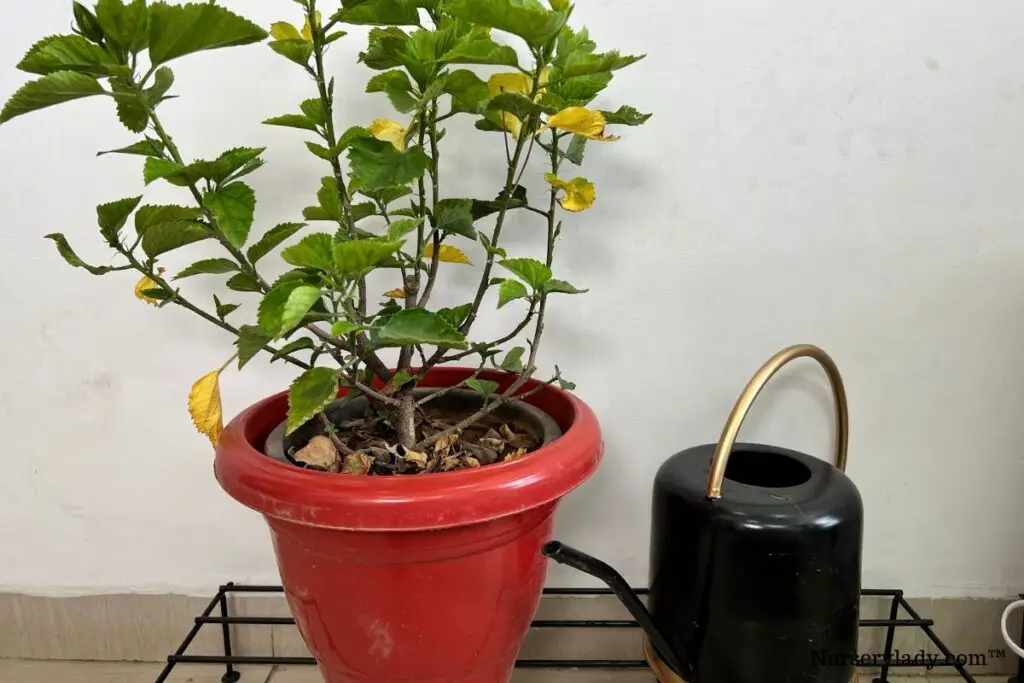
- Use well-drained soil. A good recommendation is 2 parts peat, 2 parts soil, and one part of perlite or vermiculite. You can also add compost to increase retention and nutrition.
- Don’t water the plant until the top 1-2 inches of the soil is dry.
- If your plant is under shade, relocate it to a sunny spot to let the soil dry out after watering.
- Aerate the soil around the plant base (not at the plant base) sometimes to increase the water flow and airflow.
- Avoid watering the outdoor plants during the rainy seasons.
- For potted plants, check for the drainage holes and the size of the holes.
- If there is a saucer beneath the pot, empty it from time to time. Never let the pot stand over a pool of water.
- Stop watering the moment you find any symptoms of overwatering. It will prevent the plant from having root rot.
Also read: What Kind Of Pot Is Best For Hibiscus? (Size, Material & More)
How to water the Hibiscus plant?
Hibiscus plants are moisture-loving plants that belong to tropical areas like the Pacific Islands and Asia.
Without sufficient water, the plant will not survive for a long time.
- When you water the plant, you should wet the roots too. The roots are 6 inches long. The water should reach that deep.
- If it is a container plant, water it until the excess drains out of the drainage holes. Drainage holes are a must.
- If the plant is in the ground, create a shallow well around the plant base to determine the penetrability of the soil.
- The soil should always remain moist, not soggy or wet. Before watering, always check the soil and water it when the top 1-2 inches are dry.
- Watering frequency depends on seasons. In summer, water the plant daily. Sometimes, it will need 2 times watering per day. But again, don’t forget to check the moisture level.
- Since the plant remains dormant or grows slow in winters, reduce the frequency. Overwatering chances get higher during the cold. However, you cannot stop watering even if the plant gets dormant. Always check the moisture level before watering.
Final thoughts
Since Hibiscus loves a lot of water, overwatering this plant is very easy. They need enough water during the spring and more in summer when they produce flowers or are outside.
You should be careful while handling your watering habits, especially during the rainy and winter. Skip watering during the frequent rains if your plant is outside. In the winters, reduce the frequency.
Always check the moisture level before watering. It saves a lot and prevents overwatering and root rot. When you have already overwatered your plant, nurture them with care to bring them back to life.
Reference: Wikipedia, ASPCA, Louisiana State University Agricultural Center, American Society for Horticultural Science, Tropical Hibiscus by Texas A&M University, Sciencedirect.
